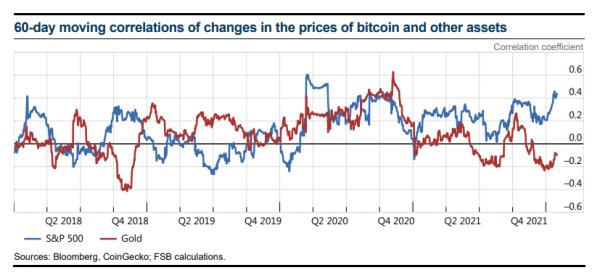The Financial Stability Board (FSB) published an updated assessment of risks to financial stability from crypto assets. Crypto asset markets are fast evolving and could reach a point where they represent a threat to global financial stability due to their scale, structural vulnerabilities and increasing interconnectedness with the traditional financial system.
The report examines developments and associated vulnerabilities relating to three segments of crypto-asset markets: unbacked crypto-assets (such as Bitcoin); stablecoins; and decentralized finance (DeFi) and crypto asset trading platforms. It notes the close, complex and constantly evolving interrelationship between these three segments, which need to be considered holistically when assessing related financial stability risks.
The report highlights a number of vulnerabilities associated with crypto asset markets, such as increasing linkages between crypto asset markets and the regulated financial system. One potential indicator of the linkages between crypto assets and the mainstream financial system is the correlation of changes in the price of crypto-assets and other financial assets. Over the past few years, the correlation between the changes in the price of crypto assets and equities has generally been negligible, but became more positive in 2020 and 2021. This could be consistent with portfolio shifts into crypto assets along with equities. Meanwhile, the correlation between changes in the price of crypto assets and commodities such as gold weakened and turned negative in 2021.

Use in payments and settlement
Stablecoins are at present primarily used to facilitate trading, lending, or borrowing of other crypto-assets on or through crypto-asset trading platforms. While their functions may evolve over time, the current generation of stablecoins are not yet used as a widespread means of payment. Uses for payment purposes are confined to certain types of domestic and international payments. Potential high transaction fees and price volatility on certain blockchains act as an impediment to their use as a form of payment.
This situation may change if transaction fees fall, or stablecoins migrate to low or zero fee blockchains. In the event that stablecoins were used more extensively for payment, they would face many of the same risks as current payment systems, including credit risk, liquidity risk, operational risk, risks arising from improper or ineffective governance, and settlement risk. When not managed effectively and comprehensively, these risks make payment systems less available and less reliable for users. In turn, this may impair the availability of critical financial services on which the real economy depends, threaten confidence, and operate as a channel through which financial shocks spread.
Areas for ongoing vigilance
Other vulnerabilities highlighted in the report include; liquidity mismatch, credit and operational risks that make stablecoins susceptible to sudden and disruptive runs on their reserves, with the potential to spill over to short-term funding markets; the increased use of leverage in investment strategies; concentration risk of trading platforms; and the opacity and lack of regulatory oversight of the sector. The report also notes wider public policy concerns related to crypto-assets, such as low levels of investor and consumer understanding of crypto-assets, money laundering, cybercrime and ransomware.
Considering the crypto asset landscape, areas for ongoing vigilance include:
- Potential increasing bank sector involvement in the crypto-asset eco-system, especially where activities give rise to balance sheet exposure to crypto-assets, not captured by (or not in compliance with) appropriate regulatory treatment.
- Institutional investors increasing their exposures to crypto-assets relative to the size of their portfolios. Risks could increase further if such exposures employ high levels of leverage, including through the use of derivatives referencing crypto assets.
- Acceleration in adoption of crypto-assets for payments. This could happen via partnerships with established payment firms or retailers/social networks.
- The growth, role and risks associated with crypto-asset trading platforms.
- Losses in crypto-assets, where accompanied by leverage, liquidity mismatch and interconnections with the traditional financial system, may amplify systemic risk arising from wealth effects. Loss of confidence in stablecoins could also trigger sales of their reserve assets, potentially affecting the functioning of short-term funding markets.
- A rapid growth of DeFi, in the absence of clearly identifiable intermediaries or parties responsible for governance, challenges core financial (stability) regulatory and supervisory disciplines and doctrines.
- Differing regulatory approaches could lead to regulatory arbitrage, thus increasing potential systemic risks.
- Data gaps impeding risk assessment and calibration of policy options.
The report notes that financial stability risks could escalate rapidly and calls for timely and pre-emptive evaluation of possible policy responses. Currently, crypto assets remain a small portion of overall global financial system assets and direct connections between crypto assets and systemically important financial institutions and core financial markets, while growing rapidly, also remain limited. Nevertheless, the rapid evolution and international nature of crypto asset markets raise the potential for regulatory gaps, fragmentation or arbitrage.

